Did you know there are over 300 artworks from The University of Queensland Art Collection on display across UQ Campuses? The UQ Art Collection features more than 4,400 artworks that are an invaluable public resource for students, staff and the broader community.
The Art on Campus program takes UQ’s extensive art collection outside the walls of the museum and into public spaces, research institutes and learning spaces across campus. In these spaces the artworks become a dynamic tool for education, research and connection across all areas of the University and create numerous opportunities to engage in the diverse cultures, histories, and stories held in the UQ Art Collection.
Below, discover some of the many artworks displayed across, libraries, research institutes, classrooms and busy hallways at UQ St Lucia.
Central Library, Duhig North Building (12)
The Central Library features several artworks from the Collection, with Gemma Smith’s “Boulder #1,” 2008, easily found on the ground floor near Bookmark Café. Smith’s artwork is a key feature of this well-known study space, due to its distinctive composition of colour and shape.
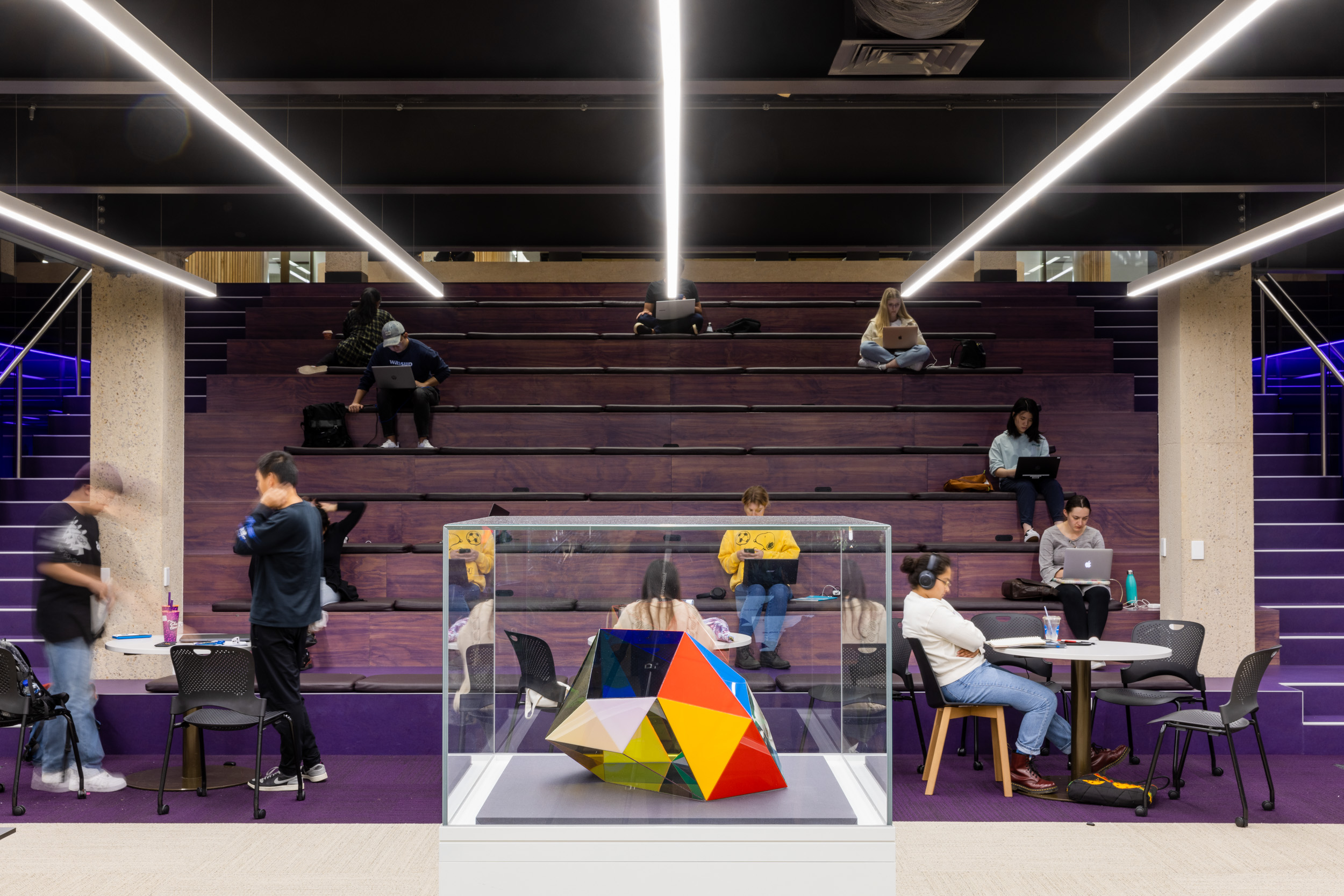
Smith’s “Boulder #1” is a crystalline structure that seamlessly blends aesthetic elements of geometric abstraction, colour field painting and minimalism. The artwork is part of a series of sculptures, which remodel and transform the reflective surfaces of the minimalist cube. Despite their static form, Smith’s “boulders” appear to be in motion and reflect the changing environment around them.
Throughout this series, Smith references the legacy of Modernist art, exploring space, colour and optical illusion. The title “boulders” complicates the way we view the artwork. It draws our attention to the physical presence of the sculpture, highlighting the tension between their artificial, lightweight nature and the heavy geological forms usually referenced by the term. "Boulder #1” invites viewers to reflect on Smith’s reimagining of the Modernist tradition to reveal her own innovative aesthetic schemes.
School of Historical and Philosophical Inquiry, Forgan Smith Building (1)
Close by, the Forgan Smith building home to the School of Historical and Philosophical Inquiry (HAPI), features an eclectic combination of paintings across its public hallways. Three large-scale artworks hold a special connection with the staff from the HAPI faculty through their references to complex global histories that inform our contemporary culture.
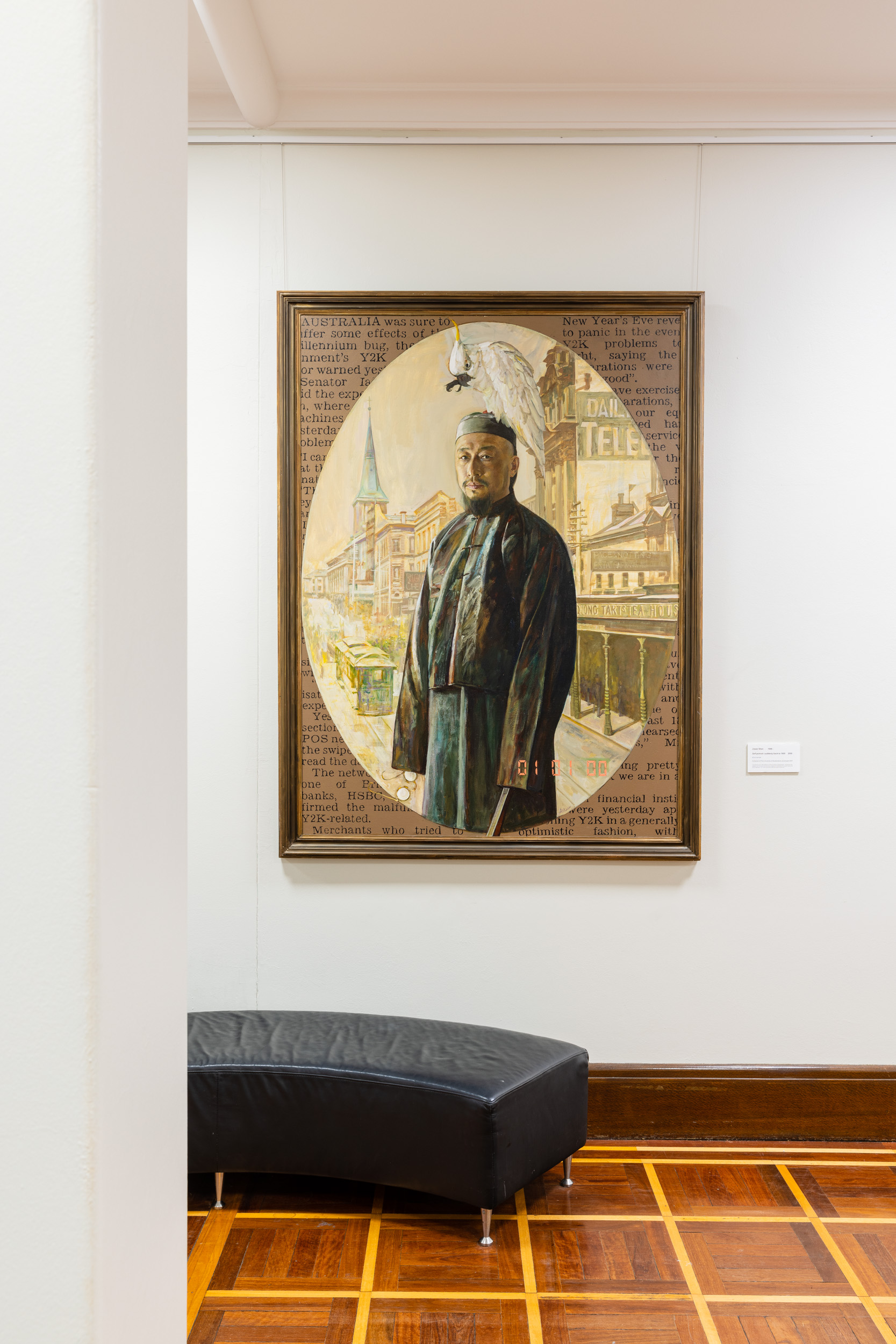
As the title suggests, “Self portrait: suddenly back to 1900”, depicts the artist in the period of 1900 wearing traditional Chinese dress with a sulphur-crested cockatoo resting upon his head. Jiawi Shen pays tribute to Mr Mei Quong Tart, a prominent Sydney merchant from China, whose business is portrayed in the background.
Through the presence of the cockatoo, Shen conveys the harmony he experienced as an immigrant living in Bundeena, alongside local Indigenous and non-Indigenous members of his community. The artist brings awareness to the idea of different nationalities finding acceptance in Australia when compared to his past experiences of living in his home country of China, or the previous historical context alluded to in the painting.

Opposite Jaiwi Shen’s painting is artwork “An End to Suffering” by Lyndell Brown and Charles Green. Building on this historical theme, their artwork delves into the evocative experiences of the 2nd Battalion, Royal Australian Regiment (2RAR) and their experiences in Nui Dat during the Vietnam War.
The collaborative artist team are well known for their hyper-realistic compositions formed by layering together fragments of found images chosen particularly for their historical and cultural resonance along with subtle personal references to the artists’ lives.
“An End to Suffering,” depicts the artists in a double self-portrait in the style of early nineteenth-century painting. Beside the couple is a view of social constructivist artwork “Monument to the Third International”, 1919-1920 by Vladimir Tatlin. Above, drapery is swept to the side to reveal part of Robert Smithson’s famous “Spiral Jetty”, 1970. In the top right corner, an old Tibetan painter is seated, whom Green personally visited in the 1980s. Below, an assemblage of postcards, newspaper clippings, book pages and images are splayed across the foreground reflecting upon the contemporary conflicts of this time period.
Throughout Brown and Green’s practice, they move between photography and painting to investigate the impact of historical events through a current lens. This complex and stimulating painting demonstrates the role of art in exploring small to major expressions of human culture.

Adjacent to Brown and Green’s painting is Alexander McKenzie's “Self portrait looking for ships,” 2006. The artwork also evokes strong narrative content with his varied use of light and colour.
A fundamental characteristic of McKenzie’s artworks is his technical ability to produce sharp detail and hazy sfumato, reminiscent of the approaches used by fifteenth-century Dutch Old masters. In his compositions, McKenzie favours the use of implied symbolism, imbuing the landscapes he paints with a sense of spirituality.
In this self-portrait, the artist depicts a luminous seascape in the background, while he stands pensively holding a lamp above his head. Through the juxtaposition of this artificial object in a natural setting, McKenzie’s artwork allows the mood of the landscape to speak to the viewer directly, evoking a contemplative emotional state.
Institute of Continuing and TESOL Education, Sir Llew Edwards Building (14)
In the Sir Llew Edwards Building, two artworks by Rosella Namok “Para way not our way,” 2001, and “Going and coming to Cairns”, 2001, have become key visual features of the building. Namok is a well-known First Nations artist originally from the Lockhart River community, whose extensive practice merges contemporary techniques with traditional storytelling.
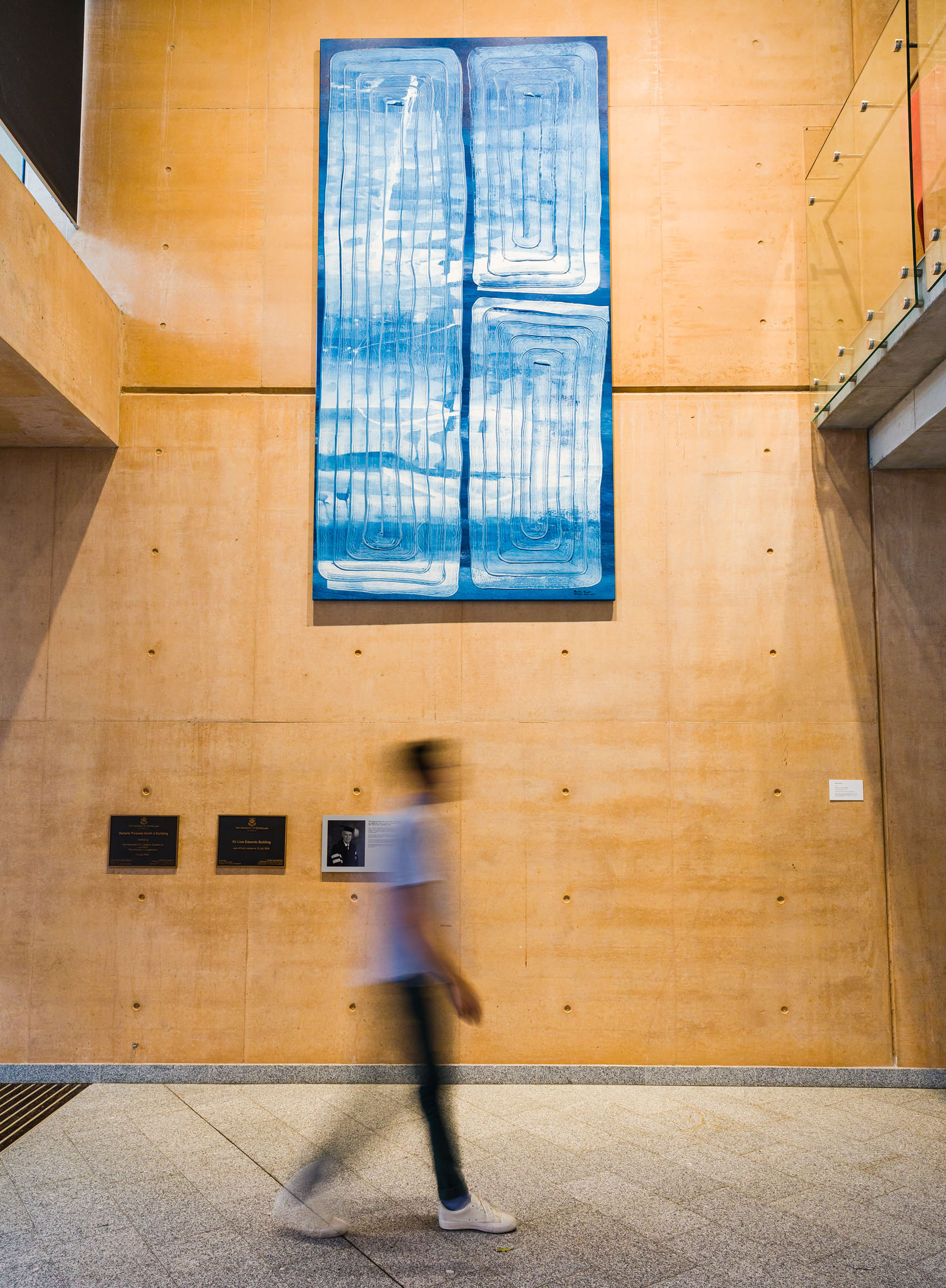
Namok’s captivating work, “Para way not our way,” stretches across the wall in the ground floor foyer entrance of the Sir Lew Edwards Building. The artist’s practice draws upon her own life experiences and “Para way not our way” sheds light particularly on the struggles faced in her community. Through thick winding brushstrokes of blue acrylic, Namok intertwines traditional symbolism with modern abstract forms, urging viewers to reflect on the complexities of cultural identity.
Another painting by Namok, titled “Going and coming to Cairns,” is displayed in the foyer of the level above. Layers of deep red and brown hues form a rich textural background while intricate lines of orange paint overlay the surface. As the title suggest, this painting centres on the ancestral journeys uniting the past and present, as people travel to and from the lush landscape of Cairns. Together, Namok’s artworks offer a window into the personal experiences and cultural narratives of her community, fostering understanding and dialogue amongst students, faculty members and visitors.
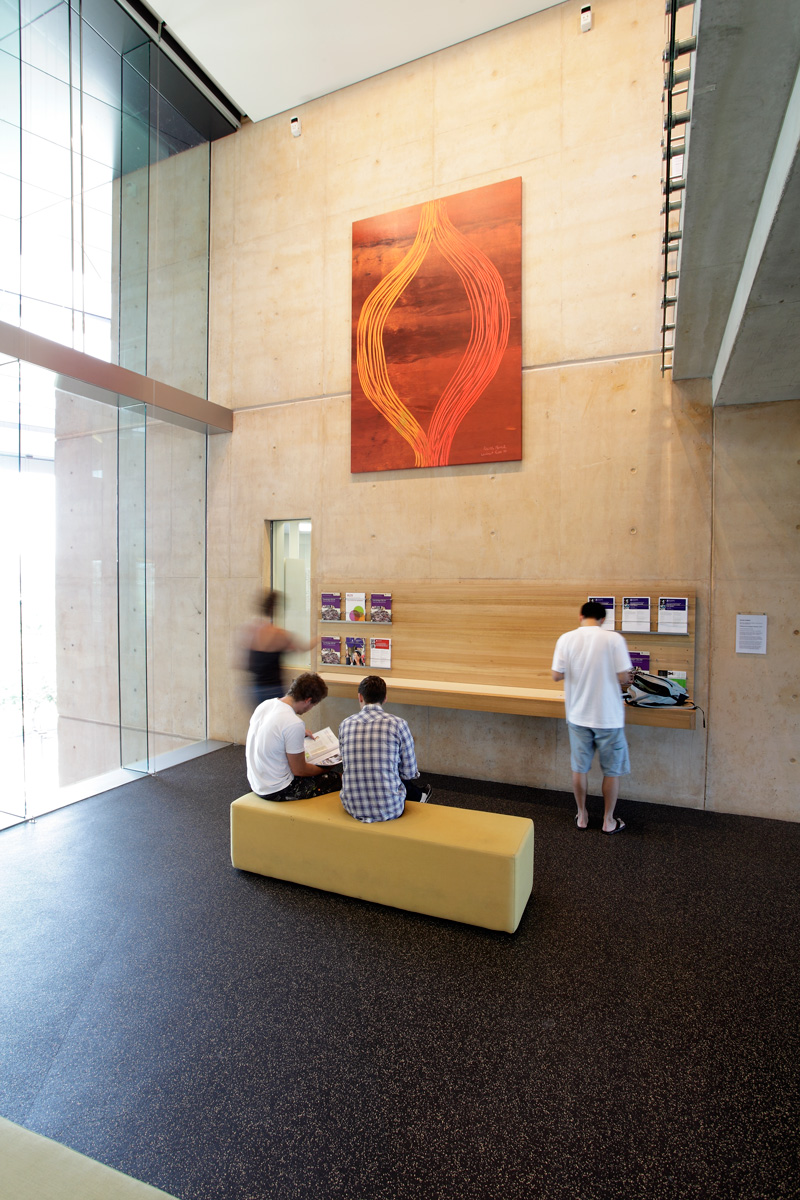
School of Languages and Cultures, Gordon Greenwood Building (32)
The Nat Yuen Collection is widely regarded as one of the most significant survey collections of Chinese antiquities in Australia, spanning 5,000 years and consisting of 84 objects. A selection of objects from the Collection are on permanent display at UQ's School of Languages and Cultures in the Gordon Greenwood building (32), UQ St Lucia.
The Collection includes objects crafted in bronze, porcelain, stoneware, paper and earthenware, and produced for purposes that ranged from the domestic to the funerary. Choices of materials such as clay and glaze, and decorative decision making around form and pattern, each reveal the unique cultural context of the period that informed how and why the objects were made.
Learn more about the Nat Yuen Collection display.
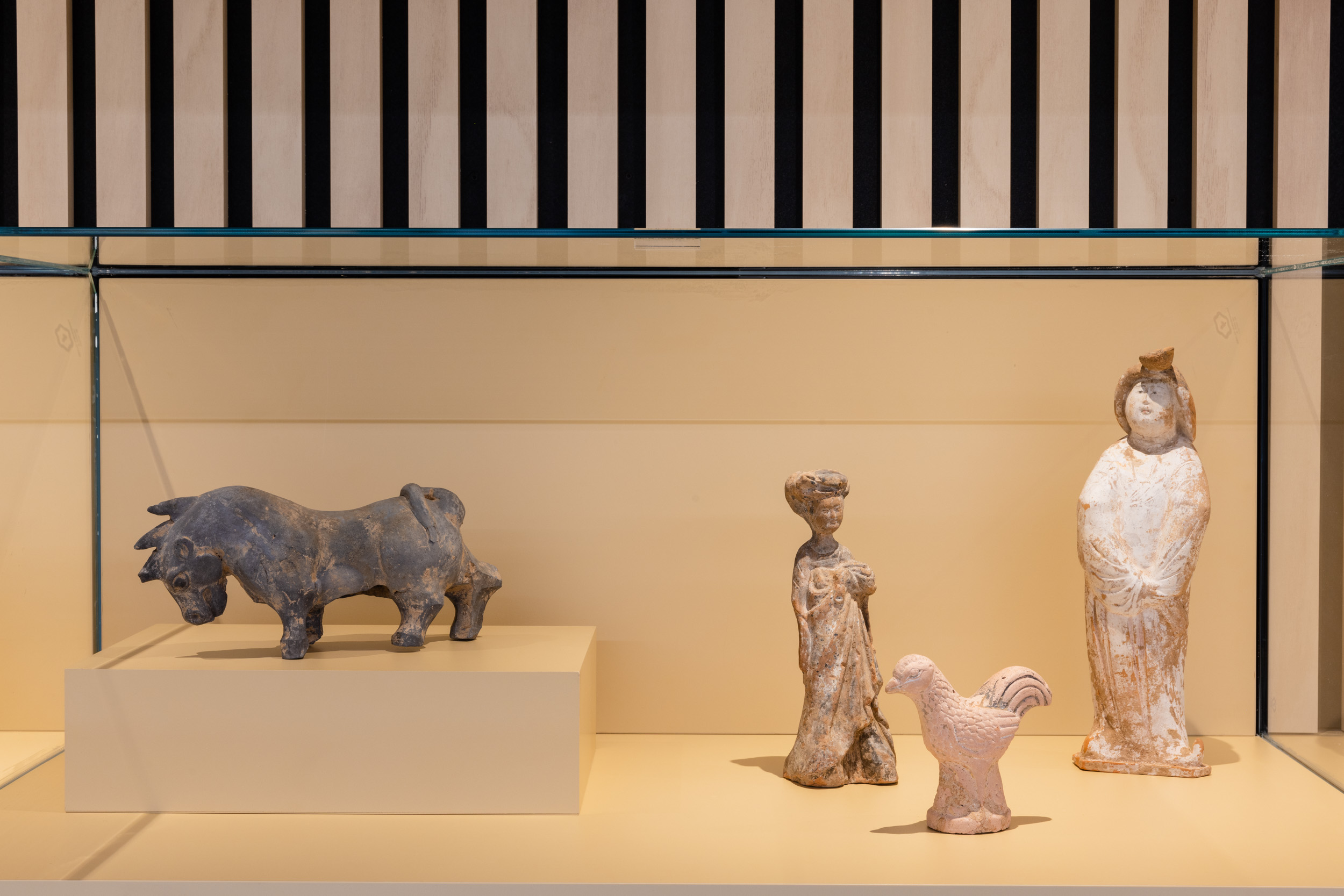
The Art on Campus program takes UQ’s extensive art collection outside the walls of museums and into classrooms, research institutes and learning spaces across campus. In these spaces the artworks become a dynamic tool for education, research and connection across all areas of the University. Creating numerous opportunities to engage in the diverse cultures, histories, and stories held in the UQ Art Collection.
Whether they are featured in the busy thoroughfare of the Central Library or in the quiet halls of Forgan Smith, the Art on Campus program illuminates the diverse narratives that shape our community.
Learn more about the UQ Art Collection.



